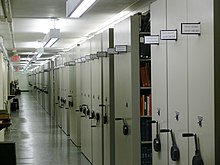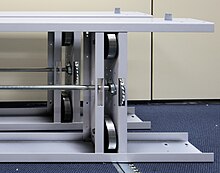Rolling shelf

A rolling rack (also shelving , running shelf , sliding rack or lever thrust system ) is a rack system , the shelf assemblies are in the on wheeled substructures which are guided over rollers or wheels in rails. The shelves can be moved so that the corresponding row of shelves opens, but the next one closes again. Mobile shelves are primarily used in libraries and archives .
Depending on the weight, mobile shelving can be used with a simple hand push, manual crank drive or electric motors. With an electric drive, the motors are built into the trolley. In the 1960s and 1970s, mobile shelving with pneumatic, gearwheel, chain and cable drive drives were also built.
While they were initially installed mainly in closed magazines, more recently they have also been found more frequently in areas with public traffic. In order to prevent people from being crushed, different measures must be taken depending on the type of output. While with a manual drive, the operator's view of the closing aisle may be sufficient, with a power drive (electric motor), increased protective measures such as B. electrical switching strips, light barriers or scanners are used.
Advantages and disadvantages
- Unlike the shelves that can be pulled out to the side in pharmacies, the shelves are pushed together except for a single aisle. By saving the traffic routes, there is a gain in magazine space of up to 100% compared to conventional shelving systems.
- However, this also increases the static load on the floor (around 12.5 kN / m² compared to around 7.2 kN / m² with conventional shelves in libraries).
- The increase in capacity comes at the expense of the transport routes. As a result, the throughput of media withdrawals and media storage with mobile shelving systems is limited compared to conventional storage systems, which prevents use in areas with high levels of public traffic. Libraries can therefore only use mobile shelves that are publicly accessible in areas with low user frequency, for example for the storage of old volumes of journals, but not for highly frequented literature such as encyclopedias, textbooks, bibliographies or current journals. Mobile shelves can, however, be used in closed library magazines, as the order in which the media is operated can be planned in these.
- From a conservation perspective, roller shelves can be problematic because they are less ventilated. With high room humidity, this can lead to an increased risk of mold.
- The ventilation can be improved with motorized mobile shelving by moving all shelves to gaps during breaks, at night and on weekends. The aisle width is divided into gaps between the shelves. In addition, fans can provide air flow between the shelves.
- There is a risk of crushing
Web links
- Ulrich Naumann: Library construction and equipment. (PDF, approx. 2 MB ) pp. 6-7 , archived from the original on June 10, 2007 ; Retrieved February 21, 2007 .

